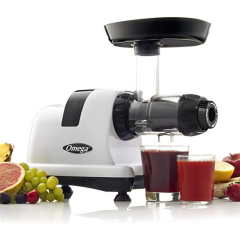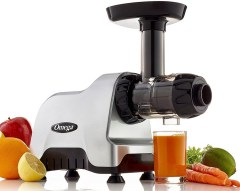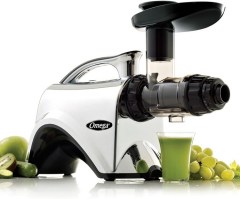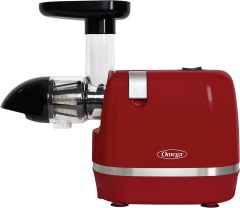
The attractive vertical design allows this versatile masticating juicer to save space on your countertop.
The attractive vertical design allows this versatile masticating juicer to save space on your countertop.
Low speed of 80 rpm helps preserve nutrients. Juice lasts longer because the temperature is kept down. Can handle fruits, vegetables, wheatgrass, and other leafy greens. Makes nut milk, too.
Some users have said it’s better for beginners than juicing aficionados.

A simple masticating juicer that’s easy to clean, operates quietly, and has an automatic pulp-ejection function.
A simple masticating juicer that’s easy to clean, operates quietly, and has an automatic pulp-ejection function.
The adjustable end cap has five settings, perfect for maximum juice output. Minimal heat buildup and oxidation, which promotes healthy enzymes. Users rave about how quiet this juicer is and appreciate the tools given to assist with the cleanup process.
The juicer works fairly slowly. Some say the pulp comes out too wet.

A compact option with full-size power that's suitable for a small apartment or kitchenette.
A compact option with full-size power that's suitable for a small apartment or kitchenette.
The low-speed function helps you get every drop of juice. Automatic pulp ejection means no extra work after juicing. Works well with fruit, veggies, leafy greens, and wheatgrass. The nutrition system also works to extrude pasta, make baby food, chop, and more.
While functional, the narrow spout is a nuisance for some, especially when cleaning.

A masticating dual-stage extractor that can handle nearly any kind of fruit or vegetable and perform other kitchen tasks as well.
A masticating dual-stage extractor that can handle nearly any kind of fruit or vegetable and perform other kitchen tasks as well.
Low speed of 80 rpm prevents oxidation to maintain healthy enzymes. Dual-stage extraction allows for greater juice yield. Can juice fruits, vegetables, and leafy greens, as well as grind coffee and spices, extrude pasta, and make nut butters, baby food, and frozen desserts.
Plastic components may not be as durable as some owners would like.

This slow masticating juicer doesn't cook the juice and keeps it fresh throughout the process.
This slow masticating juicer doesn't cook the juice and keeps it fresh throughout the process.
Runs between 90 rpm and 110 rpm, depending on the setting. Cold pressing is proven to be one of the most nutritional ways to juice. BPA-free material doesn't harm you or the fruit you put into it. Works with most juiceable ingredients. Top rack is dishwasher safe.
Some complaints that the components are too fragile.

We recommend these products based on an intensive research process that's designed to cut through the noise and find the top products in this space. Guided by experts, we spend hours looking into the factors that matter, to bring you these selections.

Getting plenty of fruits and vegetables into your diet is an important step in leading a healthy lifestyle. But if you’re not a big fan of fruits and veggies, it can be a challenge to eat enough of them each day. Juicing fruits and vegetables can be an easy way to work more kinds of produce into your diet. With an Omega juicer, it’s easy to get the most from your fruits and vegetables in as little time as possible.
Juicers, also known as juice extractors, are kitchen appliances that extract healthy juice from fruits and vegetables. Juicers allow you to enjoy all of the vitamins, minerals, and other nutrients of fruits and veggies quickly and easily in the form of delicious juice. Juice is easily digested, meaning you can get the benefits of the nutrients quickly.
Omega is one of the most respected brands in the home juicing market. Omega offers reliable, high-quality, effective juicers in several different types, allowing you to choose the option that best suits your juicing preferences. Whichever juicer you select, you’ll be able to extract fresh fruit juice and vegetable juice with the press of a button.

Omega offers three types of juicers, namely centrifugal, masticating, and twin gear juicers. While all three types can effectively juice fruits and vegetables, you may prefer one over the others.
Centrifugal juicers, sometimes known as high-speed juicers, feature a series of sharp teeth that rotate at high speeds to grind down the produce. The fresh juice is then spun to remove the pulp and passed through a filter to get rid of any smaller particles. Because a centrifugal juicer operates at such a high speed, it’s able to produce juice more quickly than its counterparts. Due to the high speed, these juicers tend to be noisy, and their powerful motor can get hot during operation, which can cause foam and oxidation in the juice that removes some of its nutrients. Centrifugal machines work best with harder, thick fruits and veggies, such as carrots and apples.
Masticating juicers, also known as low-speed or cold press juicers, use a tool called an auger that crushes fruits and vegetables with its large teeth. The crushed produce is then pressed through a juicing screen to make sure that all the juice is removed from the pulp. This allows a masticating juicer to produce a high juice yield compared to centrifugal models. Because it works at a slow speed compared to other juicers, it doesn’t create as much foam or oxidize the juice as the centrifugal models. You’ll have to wait longer for your juice, though, and do some pre-cutting or mincing of fruits and veggies before feeding the machine.
Twin gear or triturating juicers feature two gears that are placed very close to one another. When you turn the juicer on, the gears turn and crush the produce, pushing out the very dry pulp. A twin gear juicer produces a great deal of juice and can work with a wide variety of produce. These juicers operate at a speed slightly faster than masticating juicers, so you wind up with juice that contains all the important nutrients.
Centrifugal juicers are usually more budget-friendly but masticating and twin gear juicers offer quieter operation. They’re also able to handle more types of produce than centrifugal models and are usually more versatile because you can use them to make nut butter, baby food, and other recipes.
Omega also offers specialized juicers.

One of the complaints about masticating juicers is that they often tend to take up more counter space than centrifugal models. That’s because they tend to feature horizontal designs with bigger footprints. However, some Omega masticating juicers feature a vertical compact design, which allows them to take up less space on your countertop or in your cabinet.
A vertical masticating juicer combines the benefits of a centrifugal juicer with a masticating one and usually produces juice more quickly than a horizontal juicer due to its slightly higher speed. It doesn’t work as well on tougher produce like leafy greens, though, so a horizontal model may be a better option if you like to make green juice from kale and wheatgrass.
Are you looking for a cool, refreshing treat? Try a green juice popsicle. If green juice isn’t your favorite, juice something else you enjoy, pop it into a popsicle mold, and enjoy a few hours later.
When you’re choosing an Omega juicer, consider how you plan to use it. Some models are able to juice a wider range of produce and can even be used for other kitchen tasks.
All Omega juicers work well for juicing hard fruits and vegetables like apples and carrots. However, if you like to juice softer produce like tomatoes or leafy greens such as spinach or wheatgrass, you should go for a low-speed masticating or twin-gear Omega juicer. These augur-based and gear-based models do better at handling fruits and veggies like tomatoes and greens, which can be hard to work with.
Omega’s masticating and twin gear juicers also do great at a wide range of other kitchen tasks. Depending on the model that you choose, you may be able to use your juicer to make:
You may also be able to use your juicer to grind coffee and spices.
Some of Omega’s juicer models are marketed as nutrition systems, which means they do more than just extract juice. A juicer marked as a nutrition system often comes with nozzles designed to extrude dough. These nozzles can then be made into breadsticks or pasta. Omega nutrition centers may come with up to six different nozzles to create two sizes of breadstick or four kinds of pasta.
It’s usually not possible to get entirely pulp-free juice when you’re juicing your own fruits and vegetables, but some Omega juicers offer a pulp ejection feature. After the juice is extracted from your produce, it’s pressed through a strainer that spins at a high speed to remove as much pulp from the juice as possible. Instead of allowing the pulp to build up inside the juicer, though, the pulp is separated from the juice and then forced out of the machine through a separate spout. You wind up with pulp-free juice and much less mess to clean up inside the machine when you’re finished.

When you’re choosing an Omega juicer, pay attention to the size of the feed chute. If you choose a model with a larger chute, you don’t have to cut your fruits and vegetables as small as you would for a model with a smaller chute. That can cut down on your prep time considerably, so you’re able to enjoy your juice as quickly as possible.
While using a juicer is usually a pretty straightforward process, cleaning it afterward can be a serious hassle. Having a juicer with parts that are easy to remove and clean is a real benefit. Many Omega juicers have user-removable, dishwasher-safe parts that are easy to hand rinse or wash in the top rack of your dishwasher. That saves you from having to scrub out all the pulp and residue from the juicer’s nooks and crannies.
The ability to reverse the operation of the juicer can be a big help in cleaning or clearing clogged and jammed material. Some Omega juicers have controls that include the ability to reverse the action of the mechanism.
If you find yourself taking out and putting away your juicer on a frequent basis, you should pick one that’s light enough for you to pick up, and a size convenient enough without compromising on power. Look for a juicer with convenient grips or handles. For example, Omega’s horizontal masticating juicers have large, easy-to-grip built-in handles.

Omega juicers vary in price based on the type and the features that they offer. Most models cost between $70 to $525.
The most affordable Omega juicers are centrifugal models. They typically range from $70 to $300. You’ll pay more for a model with features like pulp ejection and dishwasher-safe components.
Omega twin gear juicers are a bit more expensive. They usually cost between $200 and $415, though you’ll pay more for models with features like pulp ejection, dishwasher-safe components, and an extra-large chute.
The highest-end Omega juicers are vertical and horizontal masticating models. Horizontal models typically range from $200 to $499, while vertical models usually cost between $300 and $525. They usually offer features like pulp ejection, dishwasher-safe components, and an extra-large chute. Several are marketed as nutrition systems with multiple functions like making pasta, baby food, and nut butter.


A. If you’re just starting out with juicing, an Omega centrifugal juicer may be your best bet. They’re some of the more affordable models, so you don’t need to invest too much to get started. They also produce juice more quickly than masticating juicers, which means you don’t need to devote too much time to your juicing routine. An Omega centrifugal juicer can handle most fruits and vegetables too, so you can create your favorite flavor blends.
A. Omega’s warranty protection varies from model to model. Some Omega juicers offer only a one-year warranty, while others boast 10-year warranties. Some Omega models offer an impressive 15-year warranty.
A. You don’t need to peel or seed everything you plan to juice. Some fruits and vegetables do require peeling and seeding before juicing. For example, oranges, grapefruits, kiwis, papayas, and other thick-skinned fruits should be peeled before tossing them in your juicer to prevent clogging. Waxed fruits, like store-bought apples, should also be peeled. Removing the seeds from apples and the stones from fruits like peaches and plums is also a good idea.
A. Home-made fresh juice is best drunk as soon as possible. Some of the nutritional quality is lost over time, and pulp and residues can separate and settle. Also, note that freshly made juice isn’t pasteurized like store-bought juice is, so bacteria and microorganisms may grow in the juice, especially if it isn’t refrigerated quickly.
Get emails you’ll love.
Learn about the products you’re wondering if you should buy and get advice on using your latest purchases.
